Supernatural Femme Fatales

By Shaun Tan
Founder, Editor-in-Chief, and Staff Writer
29/10/2019

It starts with a scent – the fragrant scent of frangipanis – as you walk this track at the jungle’s edge, unwisely late and unwisely alone. The Malays who live in the kampungs nearby do not leave the track at night, indeed, scrupulously avoid coming here at night at all. They whisper stories of horrors that lurk in the dark, more dangerous than any beast.
But you do not know these stories. You follow that sweet scent, its wafting, Brownian path into the undergrowth, and as you do it grows sweeter and sweeter, and then it changes, carries the hint of something else – the putrid-sweet stench of rotting flesh.
You look up, and there in front of you, perched on the branch of a tree, is a white figure, glowing spectral in the dark. You hear a chilling trill of laughter, and the hairs prickle at the back of your neck and a shiver runs through your spine and you feel real terror. You turn to run, but now the figure is in front of you, and your breath catches in your throat as it drifts into a moonbeam.
The creature before you is willowy, feminine, and achingly beautiful. The moonlight bathes her skin, flawless and alabaster, and clinging to her curves is a flowing white dress, lustrous, and delicate as mist, as if the moonlight itself clothes her form even as it reveals it. Entranced, you don’t notice that her feet do not touch the ground, that she floats above it by a few inches, that her fingernails are sharpened to claws.
Entranced, you don’t notice that her feet do not touch the ground, that she floats above it by a few inches, that her fingernails are sharpened to claws.
Her beauty is the last thought running through your head as she lunges forward hungrily, fangs bared in a predatory grin. She’ll lift you high, high into a tree, drink the blood from your palpitating neck, gorge on your organs, suck your eyes from their sockets. They’ll find your red bones at the base of the tree in the morning.
Of all the horrors of Malay and Indonesian legend, goblin-children that suck the blood from your fingers, “breast ghosts” that smother you to death with their tits, perhaps the best-known is the pontianak, a vampiric revenant of a woman who died during pregnancy, whose spirit resides in a banana tree during the day, but who emerges at night to prey on the unwary. The only way to defeat her is to hammer a nail through the back of her neck, whereupon her fangs recede and she becomes a normal beautiful woman. In many of the stories, the daring hero who subdued her then marries her, because that’s the natural thing to want to do with a beautiful woman, even if she happens to be just one nail away from a homicidal ghost. Inevitably, one day, by chance or accident, the nail buried in the nape of her neck gets removed, and she reverts to her true form, laughing and flying back into the jungle.

Interestingly, the pontianak seems to have counterparts in many other cultures. From Colombia to Ukraine, India to Japan, the supernatural femme fatale, who uses her feminine charms to lure men into disaster, often killing them or drinking their blood or draining their life-force, is a recurring character in religions, myths, and folklore.
***
Perhaps the earliest example of a supernatural femme fatale in the Western tradition is the witch-goddess Circe. In Homer’s Odyssey, the titular hero, Odysseus, and his men, find themselves on Circe’s island of Aeaea. There, Circe lures his men into her home with her sweet singing, offering them drink and hospitality, before transforming them into pigs, and then tries to do the same to Odysseus. It is only with divine help that he is able to resist her magic. Defeated, she transforms his men back into humans, aids them in their journey home, and asks Odysseus to have sex with her: “[C]ome to bed with me,” she entreats, “Through making love we may begin to trust each other more.” (Note that, as with the pontianak, the brave hero’s conquest of his foe is followed by sexual conquest.)
“[C]ome to bed with me, Through making love we may begin to trust each other more.”
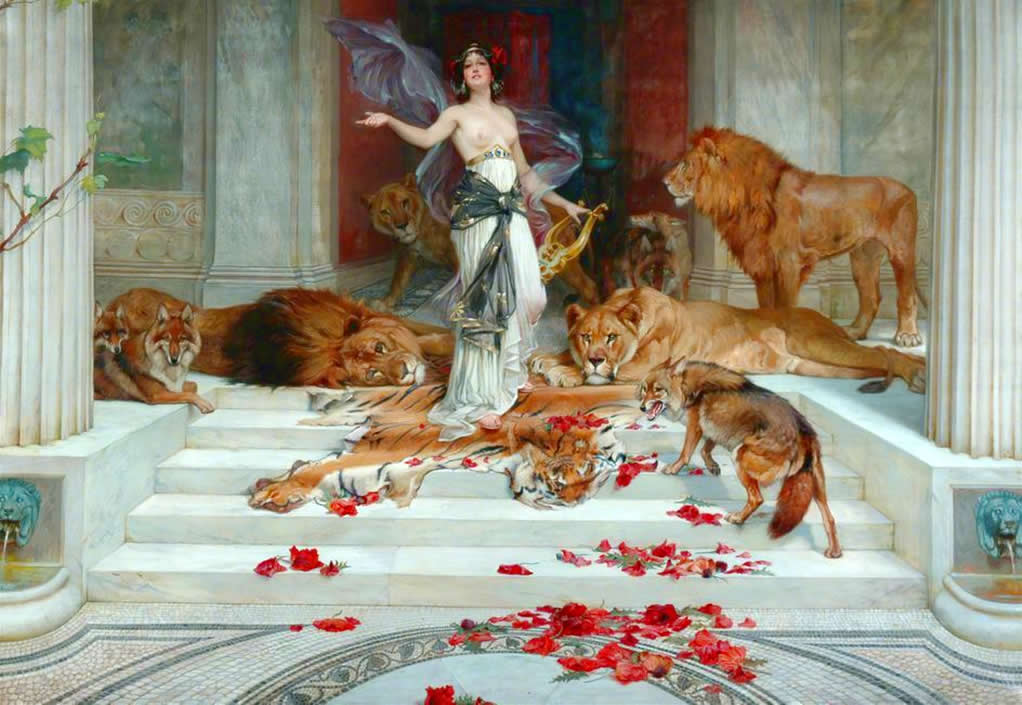
Circe by Wright Barker
Later in his journey, Odysseus sails past the island of the sirens – feminine creatures whose sweet singing entrances passing sailors, drawing them to their island like moths to a flame. It’s never revealed what exactly happens to the sailors then, but Circe describes the sirens sitting in their meadow, surrounded by “great heaps of men, flesh rotting from their bones, their skin all shriveled up.” To pass the island safely, Odysseus has to plug his men’s ears with wax so they can’t hear the singing, whilst he (wanting to listen) has them tie him to his ship’s mast.
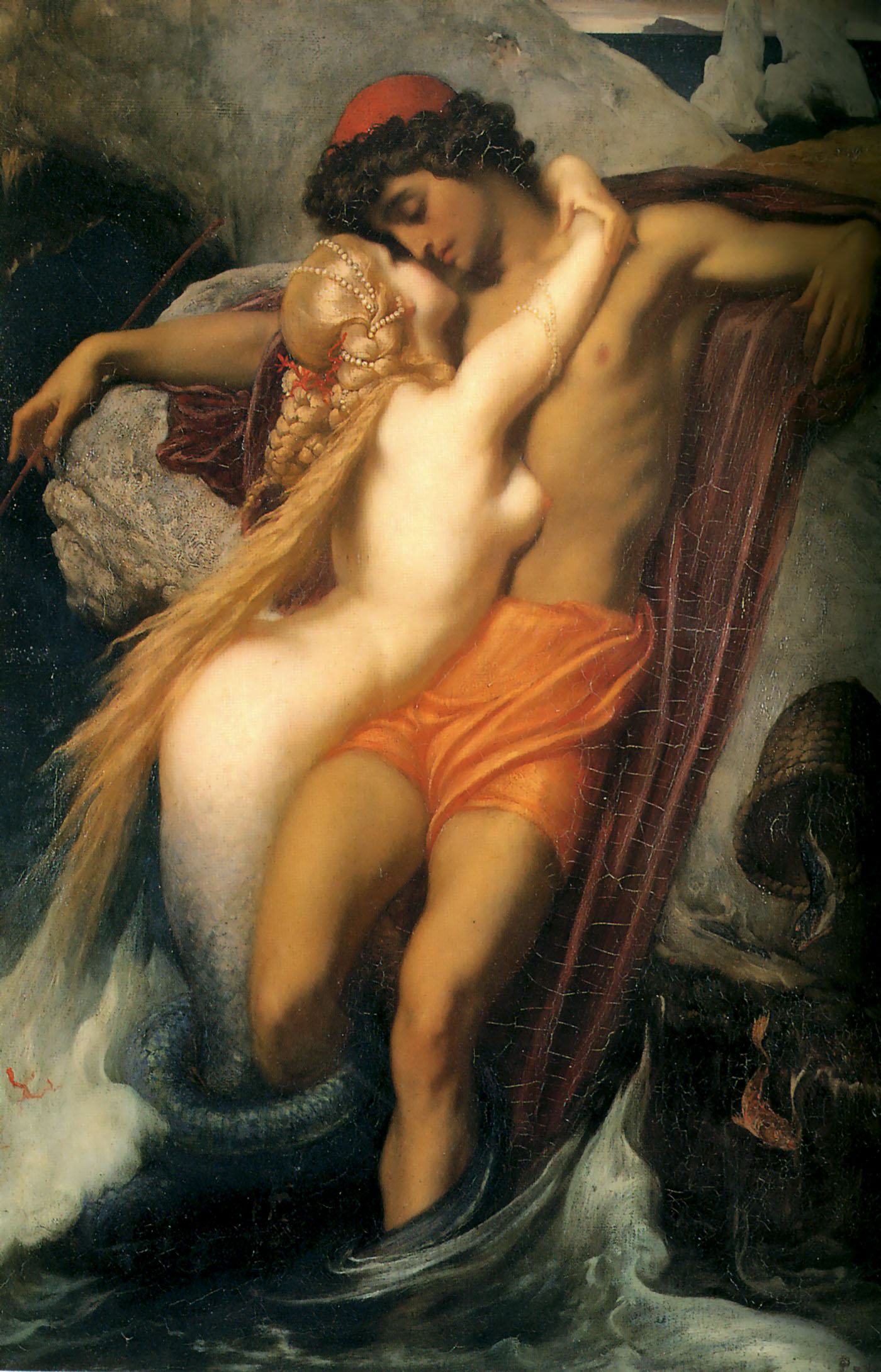
The Fisherman and the Syren by Frederic Leighton
Another ancient Greek legend tells of Lamia, a woman who had an affair with Zeus. Hera, in her jealousy, killed Lamia’s children and drove her to become a child-killing monster. Later stories imagine her seducing young men before devouring them or drinking their blood. Lamia seems to have evolved in folklore, becoming a distinct species of monster, with the head and upper body of a beautiful woman and a lower body curling into a snake’s tail (or, sometimes, a snake’s head). In The Life of Apollonius of Tyana, the Greek sophist Philostratus described lamias as “lascivious creatures, and their passion is for making love and especially for the flesh of young men. They use the pleasures of sex as a decoy for those on whom they wish to dine.” In one of his orations, “The Libyan Myth,” the Greek orator Dio Chrysostom described the hunting techniques of lamias thus:
they used guile with man, giving them a glimpse of their bosom and breasts and at the same time they infatuated their victims by fixing their eyes upon them, and filled them with a passionate desire for intercourse. Then the men would approach them as they might women, while they on their part stood quite motionless, often dropping their eyes in the manner of a decorous woman. But as soon as the man came within reach they seized him in their grasp; for they had clawlike hands too, which they had kept concealed at first.

Isabel Lilian Gloag’s Kiss of the Enchantress portrays Lamia as a serpentine monster
Then there are the Empusae, children of Hecate, goddess of sorcery. Empusae change their form at will, and often appear as beautiful women, sleeping with men and draining their life-force until they die.
In the Judeo-Christian tradition, the supernatural femme fatale first appears in the form of Lilith. Originally created by God as Adam’s first wife, according to Jewish mythology, she quickly falls out with him over who gets to be on top when they have sex. Refusing to accept what she sees as a subordinate position by lying beneath him, and indignant at his refusal to acknowledge her as an equal, she flies away. She later mates with Adam, however, during his long estrangement from Eve after they’re banished from the Garden of Eden, begetting “ghosts and male demons and female demons,” in the words of Rabbi Jeremiah ben Eleazar (2nd Century). In later myths, she subsequently becomes the consort of Samael, who some regard as a fallen angel, producing a host of demonic progeny. Over the years, Lilith seems to have developed into a succubus, a demon that assumes feminine forms to seduce men, often to collect their semen to spawn demonic offspring.
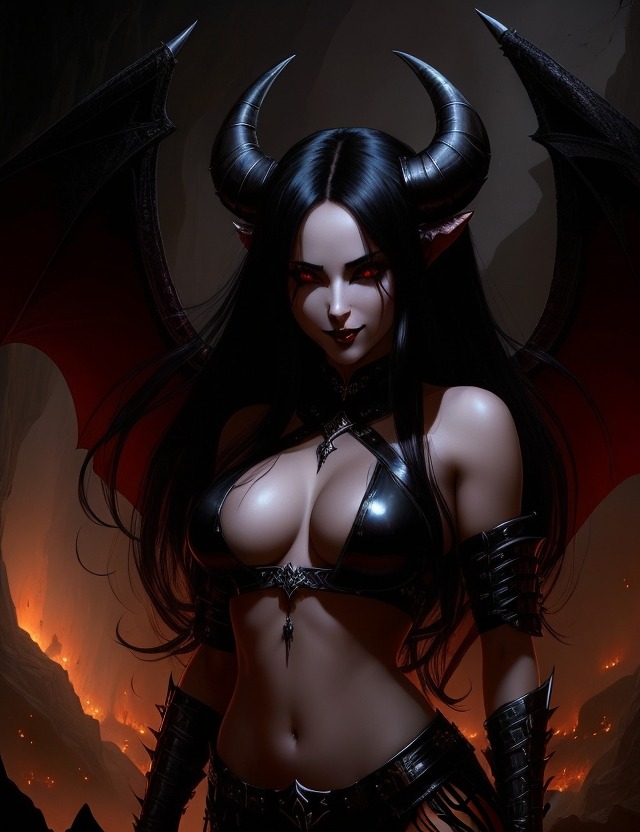
A succubus, illustrated by archelaian
Supernatural femme fatales first appear in Bram Stoker’s Dracula in the form of three vampire ladies. Jonathan Harker, one of the main characters, describes how
All three had brilliant white teeth that shone like pearls against the ruby of their voluptuous lips. There was something about them that made me uneasy, some longing and at the same time some deadly fear. I felt in my heart a wicked, burning desire that they would kiss me with those red lips.
When one of them approaches to bite him, he notes that
There was a deliberate voluptuousness which was both thrilling and repulsive, and as she arched her neck she actually licked her lips like an animal, till I could see in the moonlight the moisture shining on the scarlet lips and on the red tongue as it lapped the sharp white teeth. Lower and lower went her head as the lips went below the range of my mouth and seemed to fasten on my throat.
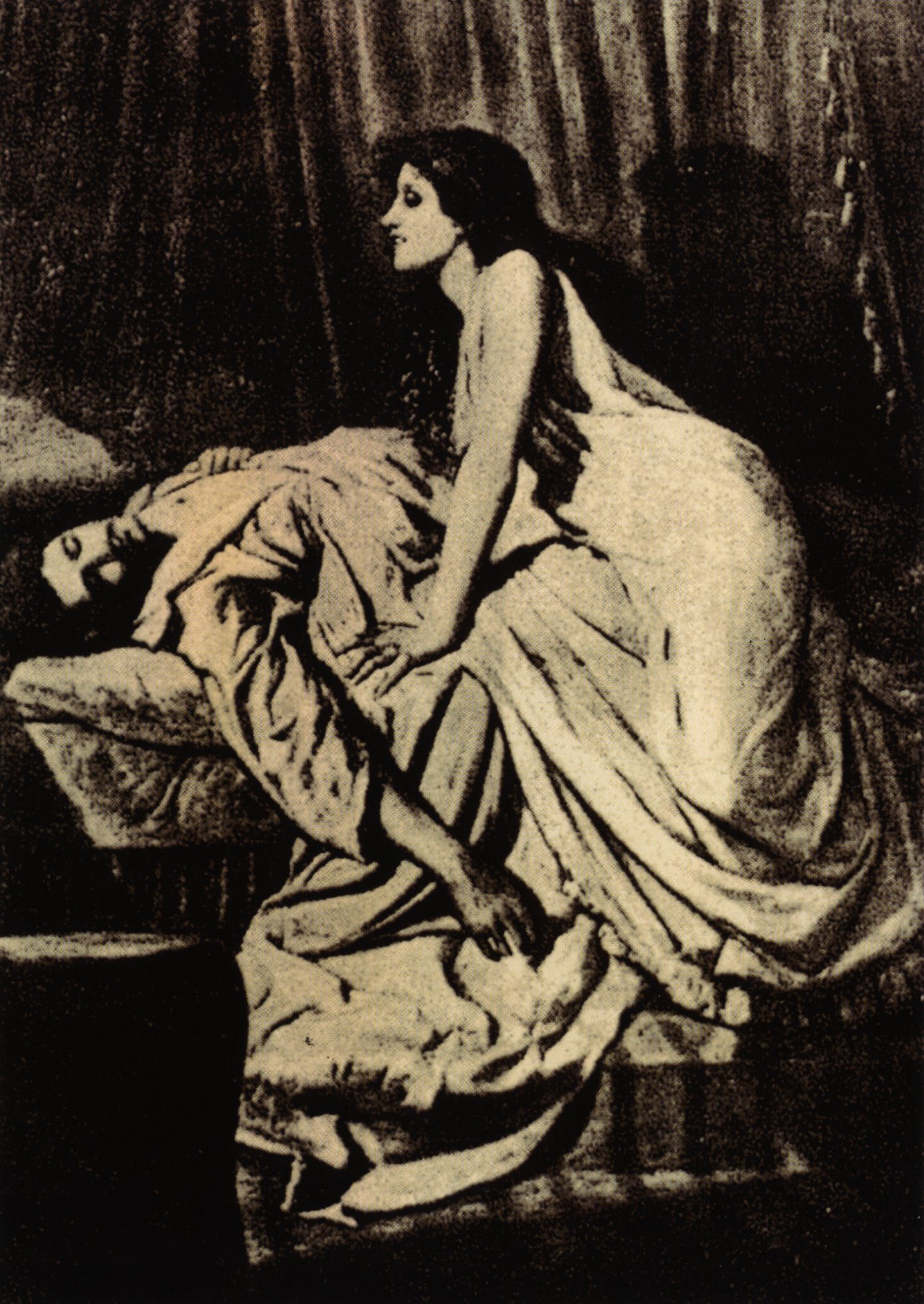
The Vampire by Philip Burne-Jones
The supernatural femme fatale has had countless incarnations across different times and cultures. The Scottish baobhan sith, a vampiric faerie, invites men to dance with her, before baring her fangs and drinking them dry. The Slavic rusalka, the soul of a young woman who died near a body of water, lures men towards it and then drowns them. The Mayan Xtabay, the restless spirit of a beautiful but cold-hearted and prudish woman, lures men into the jungle before turning into a snake and killing them. The Churels of South Asia are ghosts who seduce young men and imprison them, draining their bodies of vitality during sex until they become old and grey. Huli jing, Chinese fox spirits, often take the shape of beautiful women, and are known to bewitch men, stealing away their memories. In Japan, Kuchisake-onna, the slit-mouthed woman, is said to walk the streets at night in the guise of a young woman, appearing to proposition solitary men before cutting them in two with a pair of scissors or slitting their faces from ear to ear. In the classic Chinese novel, Journey to the West, which tells the story of the holy monk Tripitaka’s pilgrimage to India to obtain sacred Buddhist scriptures to bring back to China, female fiends are recurring villains, and seek to gain immortality by either devouring Tripitaka’s divine flesh or having sex with him and absorbing his yang essence, i.e. his masculine essence, at one point bluntly described as his sperm. The Japanese-Buddhist tradition tells of an island populated by rasetsu, shapeshifting demons who wear the guise of beautiful women. In the tale “How Sokara and Five Hundred Merchants Went to the Land of the Rasetsu,” a group of merchants think themselves in paradise when they arrive on the island and are welcomed by its inhabitants, who take them as lovers. One day, though, their leader, Sokara, discovers a prison filled with other men who visited the island, some of them reduced to half-eaten corpses, now captives of the rasetsu, who feed on their flesh. As D. Max Moerman, Associate Director of the Columbia Center for Buddhism and Asian Religions, observed in his article, “Demonology and Eroticism: Islands of Women in the Japanese Buddhist Imagination”: “The haunting figure of the femme fatale, hovering at the boundary between attraction and horror, colors the lure of eros [sex] with the threat of thanatos [death].”

In The Sorcerer and the White Snake, huli jing are portrayed as seductive demons capable of bending space
***
Why is the trope of the supernatural femme fatale so ubiquitous across civilizations that evolved largely independently from each other?
There are a number of possibilities. Perhaps it’s simply because it makes a good story. Sex is paired with violence and humor in many stories because all those things excite us. Maybe it’s unsurprising that it should therefore be paired with horror and the supernatural too.
Perhaps the answer lies in the natural world. Sexual cannibalism, in which the female eats the male (and it usually is that way round) before, during, or after copulation, can be observed in many arachnid orders and several insect orders (like black widow spiders and praying mantises). It’s possible observing this in nature prompted people to imagine a human version.
There may be a psychological explanation – sex and death may be linked in the human psyche (recall how a French term for orgasm is la petite mort (the little death)). A study published in the Journal of Personality and Social Psychology in 1999 found that the more neurotic people were about sex, the more neurotic they tended to be when confronted with the subject of death. The Bible itself seems to suggest such a link: after eating the forbidden fruit, Adam and Eve develop a fear of sex and a fear of death almost simultaneously – they become aware of their own nakedness and cover their bodies with leaves, indicating a fear of sex, and, shortly after, are cast out of the Garden of Eden and lose their shot at immortality, and so start fearing death too. Maybe it’s natural, then, for the femme fatale, who personifies both these things – who is at once death and the maiden – to be such a common feature in our stories.
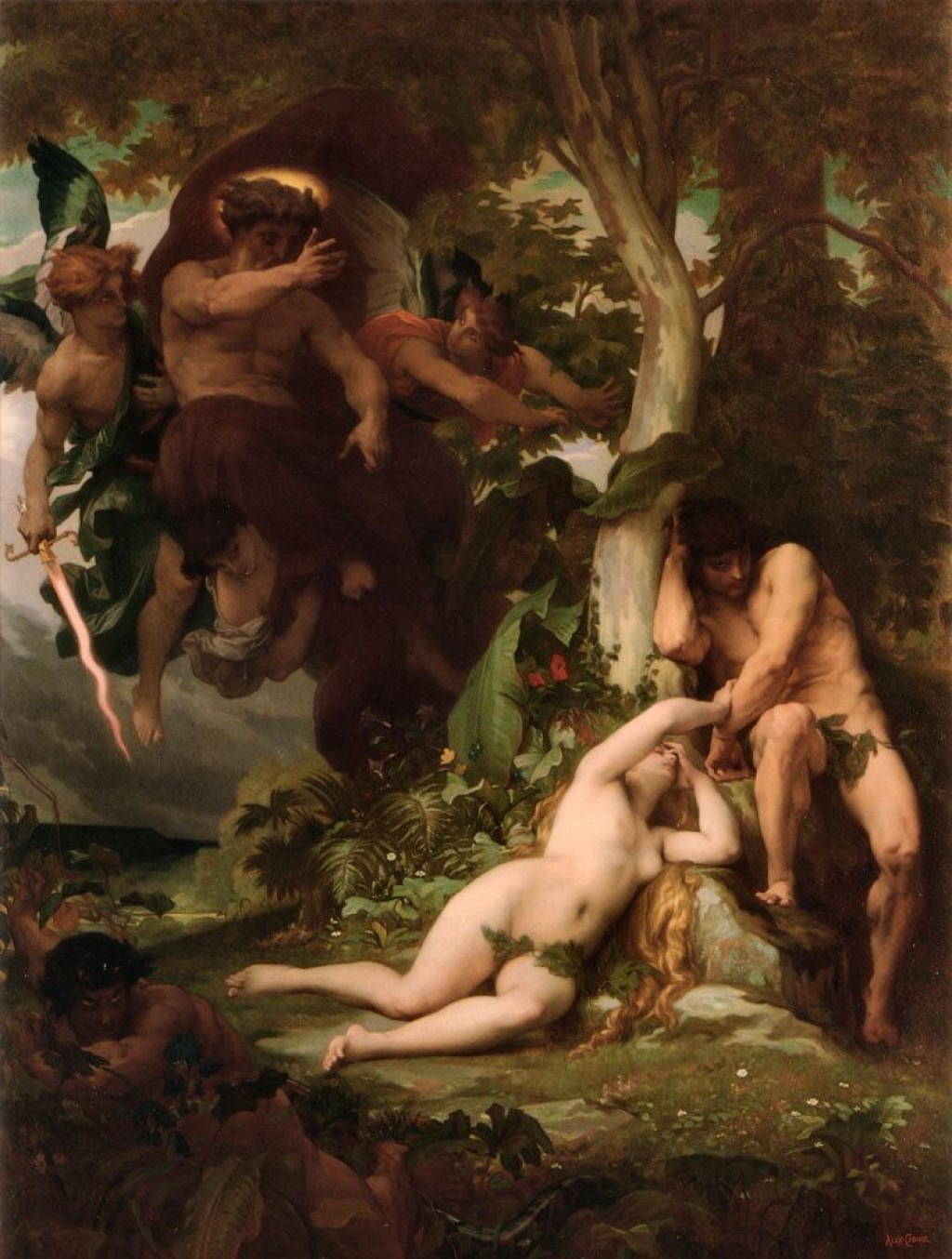
The Expulsion of Adam and Eve from the Garden of Paradise by Alexandre Cabanel
Another explanation could be rooted in power and social control. Sex is one of the oldest forms of power, something universally desired, and throughout history some have wielded it, some have labored for it, and some have fought for it. Others, especially religious figures, have realized the power they could have if they could control access to it, and, because people could not be watched all the time, regulate it with a system of purity and guilt, a system where they got to say who could have sex with whom and under what circumstances, when indulging in this most natural of acts was acceptable and when it was a sin. Inculcating a fear of sex, and, since men were the most difficult to restrain, female sexuality in particular, through such devices as the supernatural femme fatale and the vagina dentata (the mythical toothed vagina that would devour any penis put inside it) helped maintain this control.
Of course, all these rules restricting something as natural as the sexual impulse produced a whole bunch of neuroses. In the Jewish tradition, where “discharging semen in vain” both through masturbation and nocturnal emissions was considered sinful, therefore, errant believers sometimes blamed Lilith herself in her role as a succubus, claiming that she put those impure thoughts into their heads and coaxed their semen from them. “To put it bluntly,” wrote Lauren Kinrich in “Demon at the Doorstep: Lilith as a Reflection of Anxieties and Desires in Ancient, Rabbinic, and Medieval Jewish Sexuality,” “‘Lilith made me do it.’” Lilith is therefore both villain for religious authorities and scapegoat for their followers’ (or their own) transgressions of their rules.
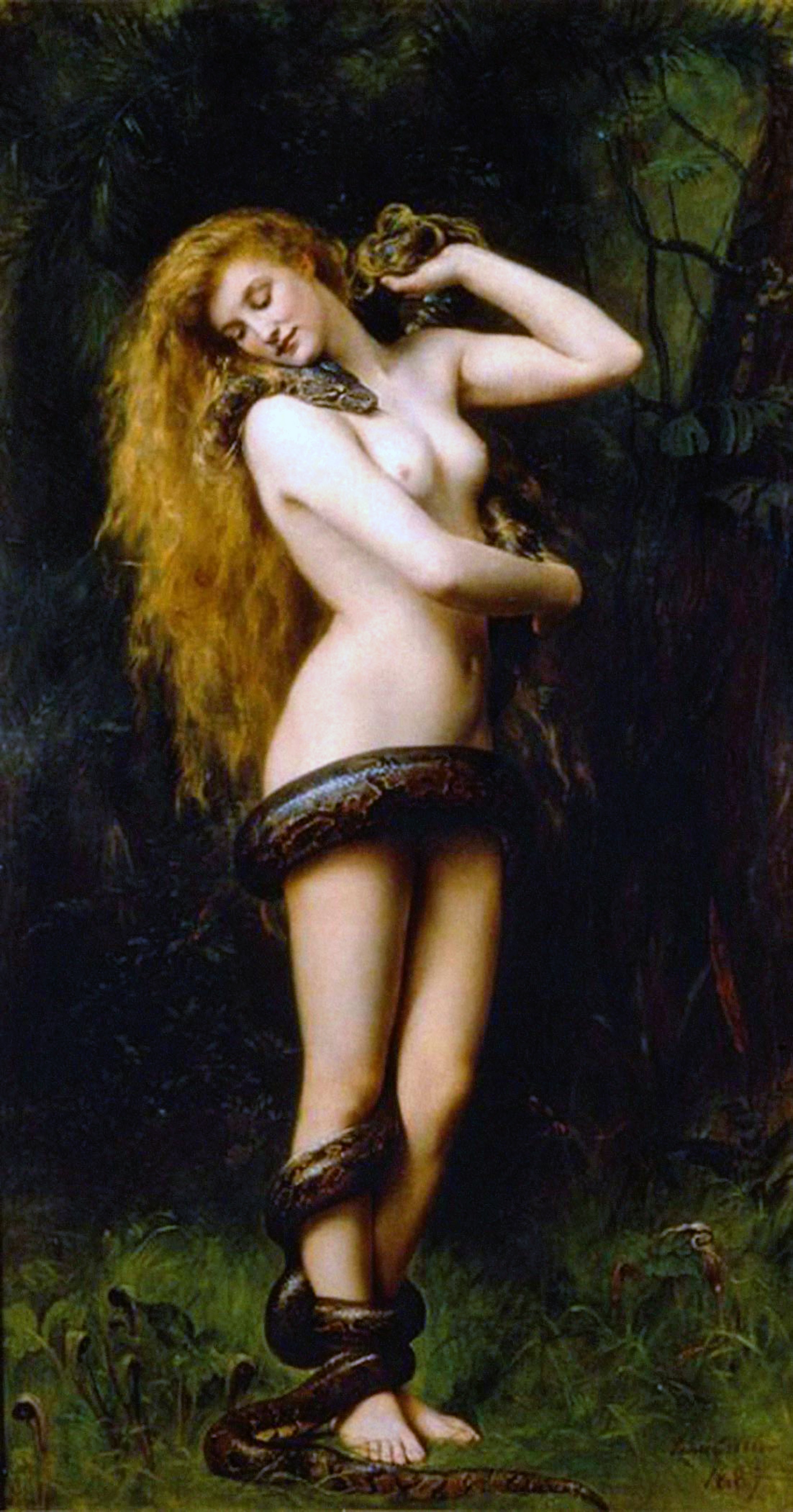
Lilith by John Collier
Like all power, the power of female sexuality is ever a threat, to jealous women as well as to patriarchs. In her novel Ponti, therefore, Sharlene Teo wrote that the pontianak myth was “told by worried wives to make their husbands wary of young, beautiful girls walking alone at night.” Likewise, some say Xtabay primarily hunts unfaithful husbands who seek out other women at night, and her story is told to dissuade men from cheating on their wives. The Venezuelan Sayona, a vengeful spirit, is said to lure men into infidelity before revealing her true, terrifying form and tearing off their genitals. To religious authorities, the supernatural femme fatale can be seen as the demonized version of what they’d consider the ultimate threat – the irresistible, sexually independent woman – for she is bound by nothing, answers to no one, reversing conventional gender roles, she is predator incarnate, she is shameless and remorseless, and so beyond their power. Lilith, of course, is the prime example of this – unabashedly sexual, defying God and his angels, refusing anything less than equal station with Adam, the very antithesis of the meek and subservient woman – is it any surprise that she’d be condemned by patriarchs or, in modern times, reclaimed as a feminist icon? “By drawing such stark comparisons,” Kinrich wrote, “the rabbis could set up a binary designed to keep women in line in the sexual sphere. If they were not faithful wives, then they were liliths, not only bad women, but not even women, rather demonesses instead.”
To religious authorities, the supernatural femme fatale can be seen as the demonized version of what they’d consider the ultimate threat – the irresistible, sexually independent woman.
One such Lilithian figure is the witch, Matilda, in Matthew Lewis’ novel, The Monk, who infiltrates a monastery and seduces the abbot, the ascetic Ambrosio, supposedly the most pious man in all of Madrid. She tempts him into breaking his vows of chastity by having sex with her, thus awakening his baser nature, a nature she then abets, encouraging him down the path of damnation, towards committing abduction, rape, and murder. (At one point, Satan appears to Ambrosio and claims that Matilda is actually a demoness he sent to lead him into perdition, though it’s ambiguous whether this is true or just one of the many falsehoods the Prince of Lies traffics in.) At the end, Ambrosio beholds Matilda in all her glory, clad in a dress “at once elegant and splendid,” diamonds blazing upon her robes, her hair ringed by “a coronet of Roses,” and radiating “a wild imperious majesty.” Matilda is every cleric’s nightmare (or wet dream): powerful, dangerous, and insatiable. As she boasts:
The Infernal Spirits obey me as their Sovereign: By their aid shall my days be past in every refinement of luxury and voluptuousness. I will enjoy unrestrained the gratification of my senses: Every passion shall be indulged, even to satiety; Then will I bid my Servants to invent new pleasures, to revive and stimulate my glutted appetites!
Historically, sexuality has been one of the few forms of power available to women; it is their oldest, most elemental form of power – and still one of their most potent. Perhaps, then, the supernatural femme fatale is a reflection of the anxieties of those who felt threatened by this power. “There’s a pretty widespread uneasiness with women having social and sexual power,” said Felicity Lufkin, lecturer on Folklore & Mythology at Harvard University, “and imaginings of deadly supernatural seductresses can be subversive and titillating, and yet at the same time conform to the existing social order in that the supernatural femme fatale is ultimately unnatural and/or evil; her power is illegitimate and she is usually punished and/or vanquished.” “The dangerous women of folktale don’t belong to any man,” said Carolyne Larrington, fellow and tutor in Medieval English Literature at Oxford University, “they are independent agents, so I think this speaks to a patriarchal fear of what women would do if given agency, and forms an argument for not allowing them to have it.”
“Women are the emissaries of hell,” went a common refrain in medieval Japanese literature, “they cut off forever the seed of buddhahood. On the outside they have the faces of bodhisattvas, but on the inside they have the hearts of demons.” Perhaps this warning was well founded. To the pious, sexuality is not just a threat to their power, but to their sense of identity and, in their own minds at least, their very souls. The power of sexuality cannot be contained, and, repressed, the desire it excites only grows stronger. A beautiful woman is raw Dionysian power, she is a wrench thrown into the divine order, a walking advertisement for the primacy of the earthly over the spiritual. To ostensibly holy men she is the death of duty, testing their vows with every breath she takes, disrupting their concentration, making the respectable look ridiculous, shattering the image they’ve constructed of themselves, exposing many of them as hypocrites, as human, all too human. How could they not recognize the power she wields, and recognizing it, how could they not fear it (for what do we fear more than power?), and fearing it, how could they not demonize it? This dynamic may be best captured in Victor Hugo’s The Hunchback of Notre-Dame, in which the villain, the ascetic Archdeacon Claude Frollo, a man who has dedicated his life to the church and is bound by vows of chastity, develops a dark obsession with the beautiful gypsy girl, Esmeralda, an obsession that torments him and leads him into corruption, such that he contrives to have her wrongly condemned for murder and witchcraft. Frollo’s emotional progression – from lust, to fear, to superstitious condemnation – can already be seen early in the story. When Frollo sees Esmeralda dancing in the streets for a crowd, he is entranced by her. She then gets her pet goat to do tricks, amazing the crowd. Frollo’s reaction, however, is to shout: “There’s witchcraft behind that!”
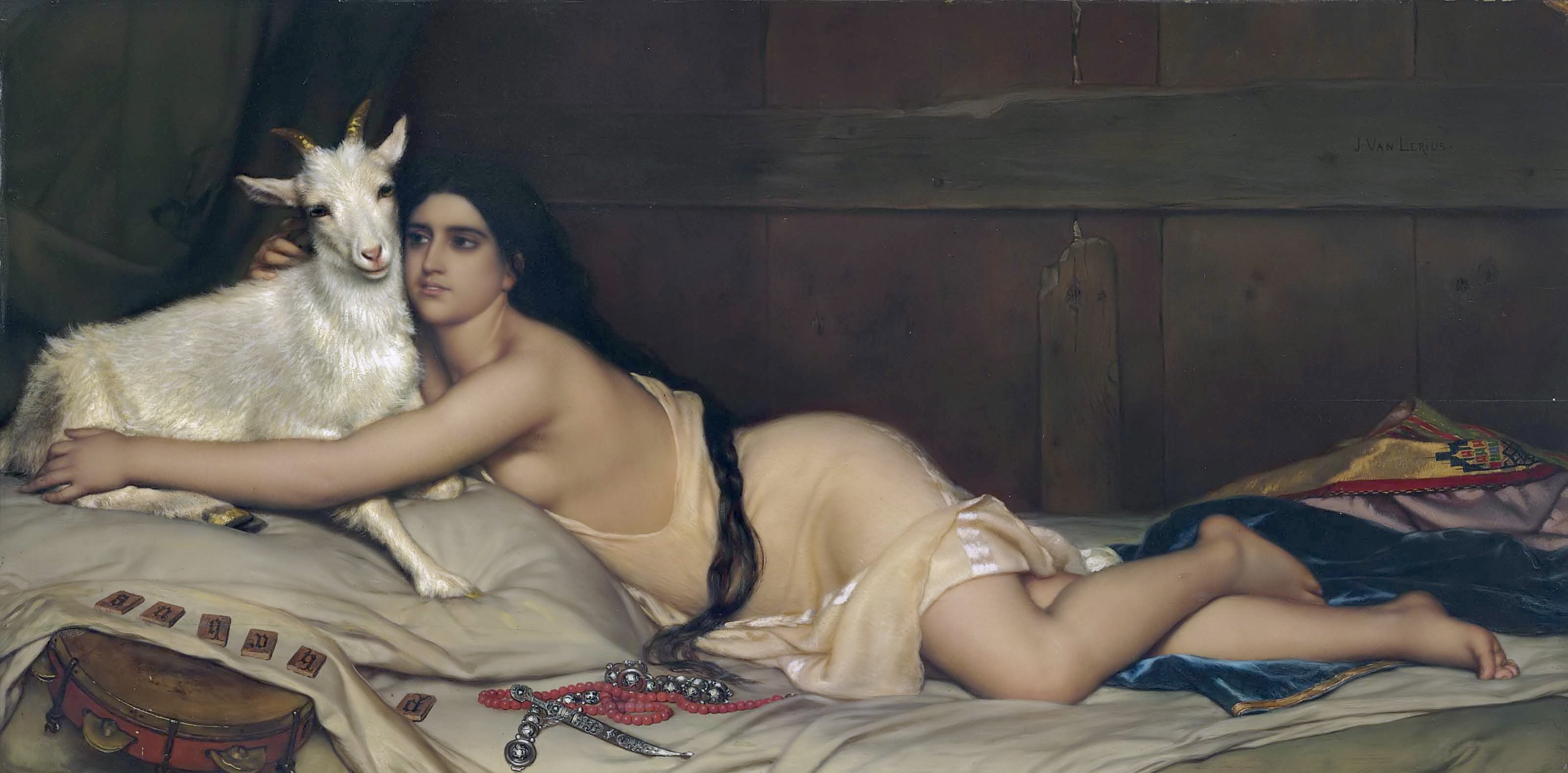
Esmeralda and Djali by Jozef Van Lerius
***
“Conjured by the fantasies and frustrations of celibate ideals, the demonic female, an object of displaced desire and one of the oldest figments of the Buddhist imagination, remained an obsessive presence in the visual and literary culture of the [Japanese medieval] age,” observed D. Max Moerman. Likewise, in Kabbalah and Criticism, Harold Bloom, legendary literary critic and Sterling Professor of the Humanities and English at Yale University, wrote that “The vision men call Lilith is formed primarily by their anxiety at what they perceive to be the beauty of a woman’s body.” Thus it is that supernatural femme fatales reflect the power of sexuality, especially female sexuality, and the unease some have towards that power.
But that begs another question: How effective are such tales at actually getting people to shun beautiful, overtly sexual women?
Perhaps a certain kind of person might be deterred by such stories. For another kind of person, though, they would only add to the appeal, making things even more exciting – what, after all, is more intriguing and enticing than something dark and dangerous and forbidden?
What’s more intriguing and enticing than something dark and dangerous and forbidden?
Recall how, in her novel, Ponti, Sharlene Teo described the role of the pontianak myth in warning men against sexual adventurism with strange, alluring women.
“Of course,” she noted, “the men don’t listen.”
Appendix: List of Supernatural Femme Fatales
Circe (Greek) – Witch-goddess, turns men into animals.
Empusa (Greek) – Shapeshifting creature, sleeps with men and drains their life-force until they die.
Lamia (Greek) – Creature that seduces young men before devouring them or drinking their blood.
Siren (Greek) – Sea creature that uses its enchanting singing to lure sailors to its island where they die.
Lilith (Jewish) – Adam’s first wife and later lover, later mate of fallen angel Samael, later imagined as a succubus.
Succubus (Judeo-Christian) – Demon, seduces men to collect their semen to spawn demonic offspring.
Baobhan sith (Scottish) – Vampiric faerie, invites men to dance with her before drinking their blood.
Glaistig (Scottish) – Satyr-like creature, lures men to her lair and drinks their blood.
Leanan sidhe (Scottish/Irish) – Fairy, becomes the lover of an artist, giving him extraordinary inspiration for his art, but drains his lifeforce in the process, causing him to die young.
Morgen (Welsh, Breton) – Water spirit, drowns men.
Mavka (Ukrainian) – Ghost, lures men into the woods before tickling them to death.
Iele (Romanian) – Spirits that dance enticingly together in a circle at night, wearing soft, translucent dresses. Found in woods and meadows. Misfortune befalls those who watch their dancing for too long: side effects include illness, madness, and paralysis.
Rusulka (Slavic) – Ghost, lures men to a body of water and then drowns them.
Xtabay (Mayan) – Ghost, lures men into the jungle before turning into a snake and killing them.
Sihuanaba (Central American) – Creature that looks like an attractive, long-haired woman from behind, but has the face of a horse or a skull, scares men to death or insanity with her ghastly visage.
Tunda (Colombian, Ecuadorian) – Shapeshifting creature, lures men into the jungle before eating them or sucking their blood.
Ciguapa (Dominican) – Creature that looks like a beautiful woman with long hair and backwards-facing feet. Lures men into the jungle before having sex with them and killing them.
Aicha Kandicha (Moroccan) – Satyr-like creature, kills men or drives them mad.
El Naddaha (Egyptian) – Jinn, hypnotizes men with her voice before killing them.
Qarinah (Arab) – Demon, has sex with men in their sleep. Similar to a succubus.
Churel (South Asian) – Ghost, imprisons young men, draining their bodies of vitality during sex until they become old and grey.
Daayan (South Asian) – Similar to a churel, imprisons men and drinks their blood.
Yakshi (Indian) – Spirit, kills men or drinks their blood.
Huli jing (Chinese), kitsune (Japanese), kumiho (Korean) – Fox spirit that often takes the shape of a beautiful woman and bewitches men.
Jorogumo (Japanese) – Spider monster that can shapeshift into a beautiful woman. Devours men.
Hone-onna (Japanese) – Animated skeleton of a beautiful woman. Appears as the woman did when she was alive, and visits the home of a former lover at night and drains the life from him. Other people can see through the illusion, and will see that man embracing a skeleton.
Hinoenma (Japanese) – Demon, feeds on men’s blood.
Kawahime (Japanese) – Aquatic monster, lures men to a body of water before draining their lifeforce.
Kuchisake-onna (Japanese) – Ghost, cuts men in two with scissors or slits their faces from ear to ear.
Nikusui (Japanese) – Monster, sucks the meat out of men.
Rasetsu (Japanese) – Shapeshifting demon, devours men.
Hantu Tetek (Malay) – Translated as “breast ghost,” smothers people to death with her huge breasts.
Pontianak (Indonesian, Malay) a.k.a. langsuir / sundel bolong – Revenant of woman who died during pregnancy, devours men.
